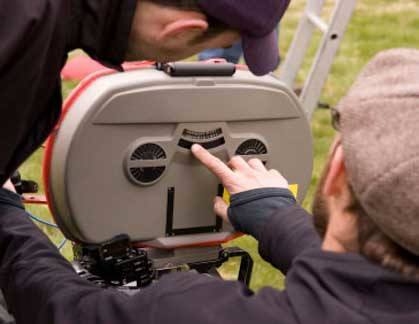Filmmaking Jobs: Who's on Set?
Find out what roles are necessary to filmmaking.
Filmmaking Jobs Defined
Reading the credits at the end of a film can be like reading a foreign language. To a film industry newbie, "best boy" and "dolly grip" aren't exactly the most enlightening job titles, after all.
There are, however, many people who dream of having their name mentioned in the credits of a major motion picture. No matter how small your role, there's a feeling of accomplishment seeing your name on the big screen.
If you're currently outside the film industry, trying to figure out your first steps to getting experience in filmmaking jobs, a little more explanation of the various roles can be helpful.
Decoding Filmmaking Jobs
Producer: Runs the business end of a film project, from finding a script to hiring to finances.
Associate Producer: Assists the producer and communicates with both the production and postproduction crew.
Production Manager: Manages the many business aspects of a production, from getting the right equipment to arranging housing for the cast and crew.
Production Assistant: Handles a variety of small tasks necessary for daily operations on the set.
Postproduction Supervisor: Coordinates the processes and workers involved in finishing the movie after filming has wrapped.
Line Producer: Handles the budget for a film project.
Director: Directs all creative elements of a film, from helping hire actors to choosing locations, and making sure that his/her vision is successfully communicated to the crew.
Assistant Director / First Assistant Director – Helps the director by planning the filming timeline and managing the set, the extras and more.
Location Manager – Scouts locations and obtains permits for filming in those locations.
Art Director – Designs and oversees set construction.
Set Designer – Responsible for executing the construction of the set according to the art director's instructions.
Cinematographer / Director of Photography: Carries out the director's vision for the look of a film. Plans and supervises others to achieve the right camera shots, lighting, and set design.
Camera Operator: Follows the action with the camera, according to instructions from the director and cinematographer.
Dolly Grip: Sets up the dolly track and operates the dolly, allowing the camera and camera crew to move smoothly as they capture the action.
Key Grip: The head grip in charge of setting up equipment to enable the camera crew to capture the right shots.
Gaffer: Sets up the lighting on set.
Best Boy: The primary assistant to either the gaffer or the key grip.
Production Sound Mixer: Records all production dialogue and other production sounds at optimal levels. May also mix the various tracks for dailies.
Boom Operator: Holds the microphone boom near the action to capture the dialog.
Foley Artist: Creates sound effects that can't be captured during filming.
Editor: Works with the director to produce the final cut of a film that both flows well and captures the director's vision for the project.
Negative Cutter: Cuts the actual negative of the film as directed by the editor, director, and others.
Take the First Step Toward a Filmmaking Job
In a filmmaking job, as in any occupation, pursuing a degree can be a good step toward achieving your career goals. Film school can give you the skills you'll need for a wide variety of filmmaking jobs—whether you have your eye set on a director role, a cinematographer job, or any of the supporting positions needed to produce a feature-length film.
Categories
Filmmaking Degree & Career Guide
- Cutting Your Teeth in the Big Apple's Film Scene
- Film School Student Profile
- Film School: Digital Opens Doors on a Global Cinema
- Filmmaking Jobs: Who's on Set?
- Filmmaking School and Career Guide
- Filmmaking School Professor Profile
- Getting Into Film School
- Getting Started in Your Filmmaking Career
- Is a Digital Filmmaking Career for You?
- Lighting Technician Filmmaking Careers
- Rankings for Film School Programs
- Screenwriting Courses or Four-Year Degree?
- Should I Earn an MFA or a BFA in Screenwriting?
- Sundance Festival Launches Film Grads' Careers
- Television Jobs: Who's on Set?
- The Los Angeles Film Scene
- The Vancouver Film Scene
- Top 5 Careers After Film School
- Unions Can Boost Your Film Career

